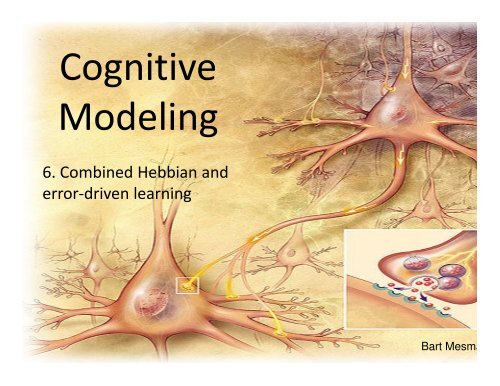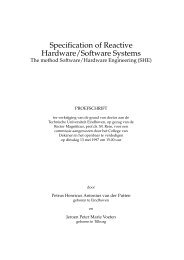Cognitive Modeling
Cognitive Modeling
Cognitive Modeling
Create successful ePaper yourself
Turn your PDF publications into a flip-book with our unique Google optimized e-Paper software.
<strong>Cognitive</strong><br />
<strong>Modeling</strong><br />
6. Combined Hebbian and<br />
error-driven learning<br />
Bart Mesma
Combined Model & Task Learning<br />
1. Pros and Cons: Use Both.<br />
2. Inhibition is also an Important Bias.<br />
3. Generalization & Deep Networks.
Biology Says: Both
Functional: Pros and Cons
Combining Error-driven + Hebbian<br />
Get benefits of both:
Inhibitory Competition as a Bias<br />
• Inhibition:<br />
• Causes sparse, distributed representations<br />
• (many alternatives, only a few relevant at any time).<br />
• Competition and specialization: survival of fittest.<br />
• Self-organizing learning.<br />
• (Often more important than Hebbian bias)
The Whole Enchilada
Generalization<br />
• How well do we deal with things we've never seen<br />
before?<br />
• nust<br />
• each time you walk into class, each social interaction,<br />
each sentence you hear, etc.<br />
• We're constantly faced with new situations, and<br />
generalize reasonably well to them.<br />
• How do we do it?
Generalization<br />
• Distributed reps: novel items are novel combinations<br />
of existing features (combinatorial representations):<br />
“nust”<br />
Hebbian & inhibition: produce elemental, combinatorial reps.
Deep Networks<br />
Need many hidden layers to achieve many stages of<br />
transformations (dramatically re-representing the problem).<br />
But then the error signals are very remote & weak.<br />
Need to add constraints and self-organizing learning:
Example: Family Trees
Sequential & Temporally-Delayed Learning<br />
• Currently: networks learn immediate<br />
consequence of a given input.<br />
• What if current input only makes sense as part<br />
of a temporally extended sequence of inputs?<br />
• What if the consequence of this input comes<br />
later in time?
• How do we do it?<br />
• For example:<br />
Sequence Learning<br />
– My favorite color is purple.<br />
– Purple my color favorite is.<br />
– Is my purple color favorite.<br />
– Is purple my color favorite.<br />
– The girl picked up the pen.<br />
– The pig raced around the pen.<br />
• We represent the context, not just the current input.<br />
• in language, social interactions, driving
Representing Context for Sequence Learning<br />
• How does the brain do it?<br />
• How would we get our models to do it?<br />
• Add layers to keep track of context (prefrontal<br />
cortex).
Representing Context for Sequence Learning<br />
Simple Recurrent Network (SRN; Elman, Jordan).
BTXSE<br />
BPVPSE<br />
BTSXXTVVE<br />
BPTVPSE<br />
An Example Task<br />
Which of the following sequences are allowed?:<br />
BTXXTTVVE<br />
TSXSE<br />
VVSXE<br />
BSSXSE
An Example Task<br />
• BTXSE, BPVPSE, BTSXXTVVE, BPTVPSE, BTXXTTVVE,<br />
TSXSE, VVSXE, BSSXSE<br />
We implicitly learn such grammars (e.g., pressing buttons faster to<br />
letters that follow grammar).
The Network<br />
• Randomly chooses one of two possible next states.<br />
• Hidden/context units learn to encode states, not labels.
















